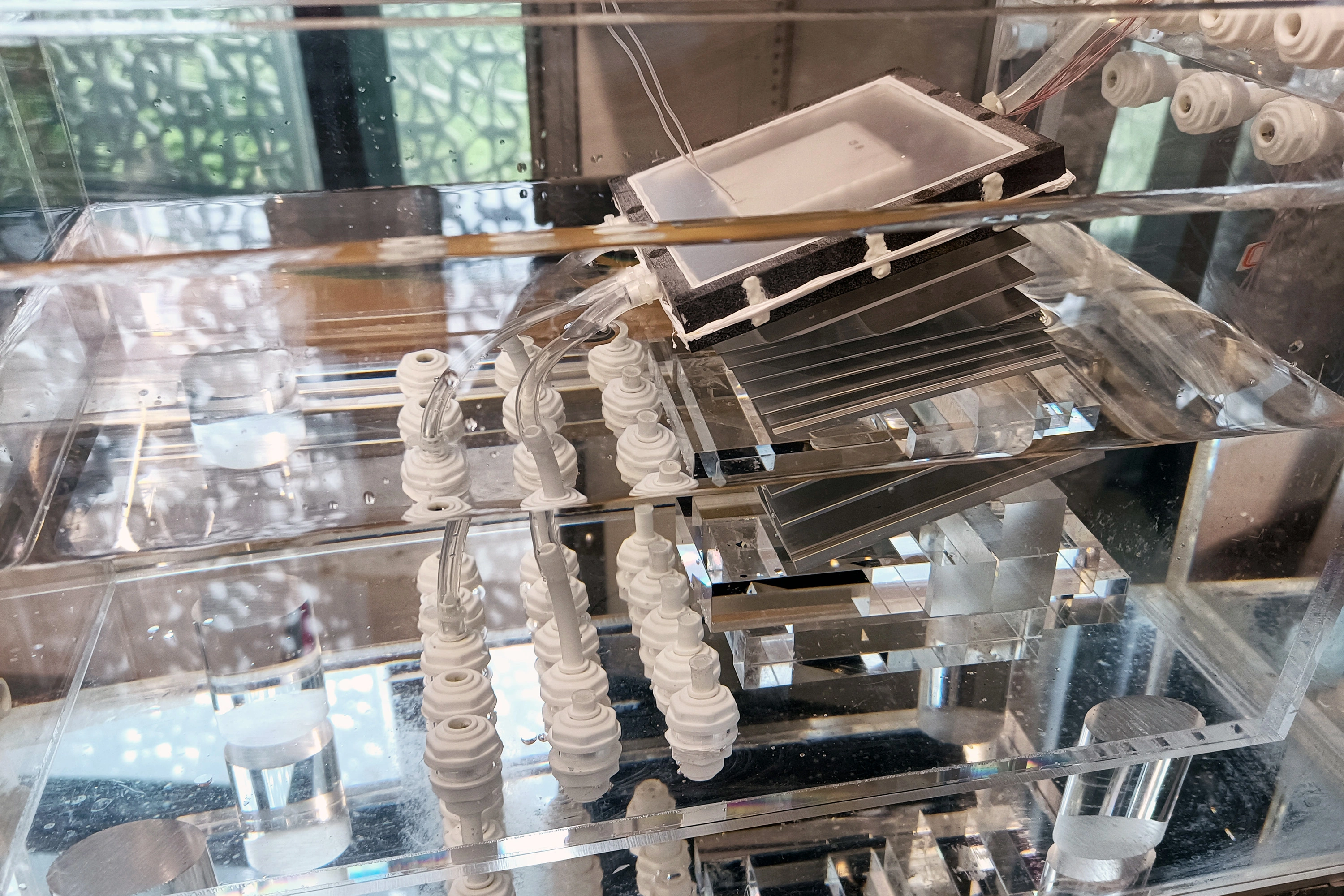According to MIT, this technology works even at small scale, with one the size of a suitcase able to desalinate 6 litres per hour, and only needing to be serviced every few years.
Ah yes, the MIT marketing department, where their premier contribution to science has been stress testing use of the word ‘could’.
For real. No where did they mention anything about its future. You just know this won’t make it out of the prototype stage just like so many other discoveries and inventions.
A person uses some 200 litres per day.
One suitcase according to their description makes 144 litres per day. So this is pretty big if it actually scales.
Depends on the person - I have seen households where a person uses less than 20 liters per day. :)
Besides, seawater can be used to wash oneself or flush a toilet - I think it’s the use of drinking water that makes a difference.
Saltwater isn’t great for utilities, because it’s extremely corrosive. The saltwater would function ok for a while, but it would eventually destroy the toilet. Additionally, the saltwater would need to be sent down the sewage for waste disposal, which the entire processing flow would need to be updated to handle saltwater.
It’s much cheaper to use freshwater to start with.
200 liters is with bathing, cooking, toilets, and all the other conveniences of modern life in industrialized Western society.
This device is aimed at small scale off grid household use - people who don’t have public water or sewer and naturally use much less.
200 is on the high end, and not all of it needs to be desalinated
Hydrohomies are statistical outliers and shouldn’t be counted
OP, you made a mistake in the title. This doesn’t scale down to suitcase size. It scales up to suitcase size. Which makes sense - water circulation powered by passive solar heating can only go so far.
And if you notice, the device is fueled by sunlight - so it needs a 3x3 square of shallow water for each “suitcase”. The devices can’t stack on top of one another. If you start putting these down along the coast you quickly run out of space - and the coastal habitat where these devices would sit is extremely valuable to both humans and animals, and if you put them too close together you start having problems with salt runoff accumulating.
This could supply fresh water for poor coastal villages or off grid homesteads. It doesn’t scale to cities.
I wanted to emphasize how well it works at small scale. But there’s nothing in the article that says it only scales to the size of a suitcase, as far as I could see, they just used that as an example.
I realize this isn’t explicitly a news community, but man, Lemmy has a thing for posting old articles as if they were just published. I mean, this is probably fine in a tech community like this, but I just want to point out how common it’s becoming across lemmy.
I posted this because I saw a video on the subject today (linked it in the post body) but wanted to post the original source instead of the video.
We could really use this. Even Egypt is looking into desalination plants because the Nile doesn’t provide enough water for Egypt’s growing needs. In Sudan it is even worse because of the brutal proxy war waging there.
A lot of the energy used in the Arabian Gulf and therefore the CO2 emissions per capita is because of that. If we could get our water efficiently we could reduce our environmental impact significantly.
Desalination has gotta be the key to absorbing carbon. We could create artificial oases (is that the plural of oasis? lmao) in Africa, Australia, and the western US and Mexico. Unlimited water for agricultural needs as well as perhaps being used to expand and grow forests. Idk if that would work but it would help a food and water security crisis while also absorbing more carbon right? Any smart people here?
You’d still need a water source, so it’d be most effective in arid climates by the ocean. And I don’t know how quickly these clog, you’d need to do something with the tons of salts that you get out of the ocean water.
God, if only there was a use for sea salt
Are you implying what I think you are?
Human need for salt is quite limited and prety much already saturated. Increased salt concentration from salt water that has been reintroduced to the ocean by desalination plants has already fucked up ecosystems.
That’s roughly my feeling too. Slap some nuclear power plants in tectonically-stable areas far from population centers and use the massive amounts of energy to desalinate.
If renewables are to handle the base load, we will need to significantly over supply them. Desalination is one of 2 obvious uses, along with hydrogen production.
Yeah, I’ve thought about that too. Use nuclear power in remote, stable locations to produce hydrogen fuel.
The big issue with that is that it’s already too late. We need a solution yesterday, not in 10-20 years. Nuclear should have been part of that, it’s perfect for base load.
Unfortunately, politics and fear have effectively killed it for now. Too much knowledge has been lost, due to people getting old and retiring. The Chinese are doing well bootstrapping back up, but even they are well behind.
Better late than never, what would you prefer?
We should definitely be pursuing proper nuclear power. The more modern designs are a massive step up from the bomb factories of the last century. They are a lot safer, as well as not producing significant amounts of waste. (Fyi, most coal power stations would fail on radioactive emissions, coal contains enough radioactive material to be above the limit).
My point is we can no longer rely on them to get to carbon neutral in time to not completely screw the planet. Renewables will have to carry the whole load. To do that they will need to significantly oversupply, matching average to average won’t work. In that case, we need somewhere to dump/use the excess energy.
Why frame it as “nuclear or renewables”? We need both.
Would building one of the salt towers with mirrors from the salt gained from the desalination process be a better solution?
Solar thermal power plants? I can definitely see large scale use of them. The salt is generally not the limiting factor building them, however.
It’s often just easier to dump excess salt back into the sea.
Dumping salt into the sea like that causes major problems in the local ecosystem.
I was thinking instead of a nuclear plant for power, the salt could be used for the tower to power the desalination plants and prevent the salt from being dumped in the ocean, which can damage the ecosystem.
Mb stupid question, but does desalinated water have any minerals?
None to very little. This device is a solar evaporator, so most the minerals would stay behind. Some minerals will be carried up by convection with the evaporating water, but not a lot.
In a reverse osmosis plant, it uses tiny filters that only allow water molecules and smaller to pass through, so it would be possible for some lithium or other small minerals to get through.
Makes sense, that’s what I thought. So do you add minerals afterwards or how do you proceed after extruding the water? If you were to use it for human consumption.
Fresh water also has very little in the way of minerals. From what I could find, most of them are in the range of 1% of your daily requirement per liter. The exceptions are calcium, sodium and chloride, and iodine. Iodine in water already varies enough that it is already supplemented in salt, low sodium and chloride is rarely a problem and can be easily corrected with table salt, and that leaves calcium. It is pretty high in harder water, but that still only hits about 10% of your daily intake per liter. If you drink a lot of harder water and don’t eat a lot of high calcium foods, this could matter.
So yes, you should be aware of this for distilled or reverse osmosis water, but you may not have to change anything depending on your diet.
There isn’t much that gets through in reverse osmosis. It’s very soft water.
Lithium extraction is exciting, though. There’s some projects out there that suggest the process would be profitable on the non-lithium minerals alone, and then you get clean drinking water on top of it.
Depends how is desalinated.
So there are different processes and some keep the minerals?
This is groundbreaking!
We’ll have enough salt to last forever!
Thanks to the Star Wars sequels, we’ll have enough salt to last forever.
What will happen to the salt?
Because the device is tilted, saltier water flows out of the device and back into the main salt water reservoir due to having more mass than the less salty water. As long as the main reservoir was regularly flushed with new salt water, it would never become dangerously concentrated to marine life, which is a major advantage.
If scalable… nifty
Sea salt is also a possible source of lithium, so you could possibly mine and filter it for various resources.
Eat it
If you can get it dry enough, there are huge underground salt mines that could be back filled.
But an larger ocean usually has enough currents that it dillutes out well enough to not be a major issue.
It’s shot in to space!










